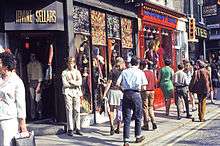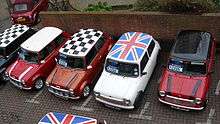Swinging London

The term Swinging London refers to a youth-driven cultural revolution that took place in London during the 1960s.[1] It saw a flourishing in art, music and fashion, and was symbolized by the city's "pop and fashion exports," like the British Invasion, Mary Quant's miniskirt, popular fashion models such as Twiggy and Jean Shrimpton, the mod subculture, the iconic status of popular shopping areas (such as King's Road, Kensington and Carnaby Street), the political activism of the anti-nuclear movement; and sexual liberation.[1] Music was a big part of the scene, with "the London sound" including the Who, the Kinks, the Small Faces and the Rolling Stones; bands which were the mainstay of pirate radio stations like Radio Caroline and Swinging Radio England.[2] The Swinging London also reached British cinema, which "saw a surge in formal experimentation, freedom of expression, colour, and comedy."[1] During this period, "creative types of all kinds gravitated to the capital, from artists and writers to magazine publishers, photographers, advertisers, film-makers and product designers."[2]
During this era, London "[metamorphosed] from a gloomy, grimy post-War capital into a bright, shining epicentre of style."[2] The phenomenon was caused by the large amount of young people in the city (due to the baby boom of the 1950s) and the postwar economic boom.[2] Following the abolition of the national service for men in 1960, these young people enjoyed greater freedom and fewer responsibilities than their parents' generation,[2] and "[fanned] changes to social and sexual politics."[1] However - and despite shaping the popular consciousness of Britain in the 1960s - Swinging London was a West End-centered phenomenon that only happened among young, middle class people, and was considered "simply a diversion" by some of them. The swinging scene also served as a consumerist counterpart to the countercultural British underground of the same period. Simon Rycroft writes: "Whilst it is important to acknowledge the exclusivity and the dissenting voices, it does not lessen the importance of Swinging London as a powerful moment of image making with very real material effect."[3]
Background
Swinging London was a youth-oriented phenomenon that emphasized the new and modern. It was a period of optimism and hedonism, and a cultural revolution. One catalyst was the recovery of the British economy after post-World War II austerity which lasted through much of the 1950s. "The Swinging City" was defined by Time magazine on the cover of its issue of 15 April 1966, with the magazine pronouncing London the global hub of youthful creativity, hedonism and excitement: “In a decade dominated by youth, London has burst into bloom. It swings; it is the scene",[4][5] and celebrated in the name of the pirate radio station, Swinging Radio England, that began shortly afterward. However, "swinging" in the sense of hip or fashionable had been used since the early 1960s, including by Norman Vaughan in his "swinging/dodgy" patter on Sunday Night at the London Palladium. In 1965, Diana Vreeland, editor of Vogue magazine, said "London is the most swinging city in the world at the moment."[6] Later that year, the American singer Roger Miller had a hit record with "England Swings", which steps around the progressive youth culture (both musically and lyrically). 1967 saw the release of Peter Whitehead's cult documentary film Tonite Lets All Make Love in London which accurately summed up both the culture of Swinging London through celebrity interviews, and the music with its accompanying soundtrack release featuring Pink Floyd.
Music

Already heralded by Colin MacInnes' 1959 novel Absolute Beginners, Swinging London was underway by the mid-1960s and included music by the Beatles, the Rolling Stones, the Kinks, the Who, the Small Faces, the Animals and other artists from what was known in the US as the "British Invasion". Psychedelic rock from artists such as Pink Floyd, Cream, Procol Harum, the Jimi Hendrix Experience and Traffic grew significantly in popularity. This sort of music was heard in the United Kingdom over pirate radio stations such as Radio Caroline, Wonderful Radio London, and Swinging Radio England because the BBC did not allow this on their radio station.
Fashion and symbols
During the time of Swinging London, fashion and photography were featured in Queen magazine, which drew attention to fashion designer Mary Quant.[7][8] Mod-related fashions such as the miniskirt stimulated fashionable shopping areas such as Carnaby Street and King's Road, Chelsea.[9][10]

The model Jean Shrimpton was another icon and one of the world's first supermodels.[11] She was the world's highest paid[12] and most photographed model[13] during this time. Shrimpton was called "The Face of the '60s",[14] in which she has been considered by many as "the symbol of Swinging London"[12] and the "embodiment of the 1960s".[15] Other popular models of the era included Veruschka, Peggy Moffitt, and Penelope Tree. The model Twiggy has been called "the face of 1966" and "the Queen of Mod," a label she shared with others, such as Cathy McGowan, host of the television rock show, Ready Steady Go! from 1964 to 1966.[16]
The British flag, the Union Jack, became a symbol, assisted by events such as England's home victory in the 1966 World Cup. The Mini-Cooper car (launched in 1959) was used by a fleet of mini-cab taxis highlighted by advertising that covered their paintwork. The Jaguar E-Type sports car was another British icon of the 1960s.[17]
Film

The phenomenon was featured in many films of the time, including Darling (1965), The Knack …and How to Get It (1965), the Michelangelo Antonioni film Blowup (1966), Alfie (1966), Morgan: A Suitable Case for Treatment (1966), Georgy Girl (1966), The Jokers (1967), Casino Royale (1967), Smashing Time (1967), To Sir, with Love (1967), Bedazzled (1967), Poor Cow (1967), I'll Never Forget What's'isname (1967), Up the Junction (1968), Joanna (1968), Otley (1968), The Magic Christian (1969), The Brain (1969), and Performance (1970).[18]
The comedy films Austin Powers: International Man of Mystery (1997) and Austin Powers: The Spy Who Shagged Me (1999) resurrected the imagery, as did the 2009 film The Boat That Rocked.[17]
Television
- The ITV spy-fi series The Avengers (1961-1969), particularly after it began broadcasting in colour, reveled in its Swinging London setting.[19]
- In the episode "Beauty is an Ugly Word" (1966) of BBC's Adam Adamant Lives!, Adamant (Gerald Harper), an Edwardian adventurer suspended in time since 1902, was told, "This is London, 1966 – the swinging city."[20]
- The BBC show Take Three Girls (1969) is noted for Liza Goddard's first starring role, an evocative folk-rock theme song ("Light Flight" by Pentangle), West Kensington location, and scenes in which the heroines were shown dressing or undressing.[21]
- "Jigsaw Man", a 1968 episode of the detective series Man in a Suitcase, opened with the announcement: "This is London... Swinging London".[22]
See also
- 1960s in fashion
- British invasion
- Cool Britannia, a Britain-wide phenomenon in the 1990s and 2000s.
- Freakbeat
- Pop art
- Youthquake (movement)
- Timeline of London 1940s–1990s
References
- 1 2 3 4 Wakefield, Thirza (15 July 2014). "10 great films set in the swinging 60s". British Film Institute. Retrieved 5 November 2016.
- 1 2 3 4 5 "Swinging 60s - Capital of Cool". History. AETN UK. Retrieved 5 November 2016.
- ↑
- ↑ "The Diamond Decades: The 1960s". The Telegraph. 10 November 2016.
- ↑ most famous (if not the first) identification of Swinging London Gilbert, David (2006) "'The Youngest Legend in History': Cultures of Consumption and the Mythologies of Swinging London" The London Journal 31(1): pp. 1–14, page 3, doi:10.1179/174963206X113089
- ↑ Quoted by John Crosby, Weekend Telegraph, 16 April 1965; and in Pearson, Lynn (2007) "Roughcast textures with cosmic overtones: a survey of British murals, 1945–80" Decorative Arts Society Journal 31: pp. 116–37
- ↑ Barry Miles, 2009. The British Invasion: The Music, the Times, the Era Sterling Publishing Company, Inc., 2009
- ↑ Ros Horton, Sally Simmons, 2007. Women Who Changed the World
- ↑ Armstrong, Lisa (17 February 2012). "Mary Quant: 'You have to work at staying slim - but it's worth it'". The Telegraph. Retrieved 17 October 2012.
- ↑ DelaHaye, Amy (2010). Steele, Valerie, ed. The Berg Companion to Fashion. Oxford: Berg. pp. 586–588. ISBN 1847885632.
- ↑ Burgess, Anya (10 May 2004). "Small is still beautiful". Daily Post.
- 1 2 "The Girl Behind The World's Most Beautiful Face". Family Weekly. 8 February 1967.
- ↑ Cloud, Barbara (11 June 1967). "Most Photographed Model Reticent About Her Role". The Pittsburg Press.
- ↑ "Jean Shrimpton, the Famed Face of the '60s, Sits Before Her Svengali's Camera One More Time". 07 (21). 30 May 1977.
- ↑ Patrick, Kate (21 May 2005). "New Model Army". Scotsman.com News.
- ↑ Fowler, David (2008) Youth Culture in Modern Britain, C.1920-c.1970: From Ivory Tower to Global Movement – A New History p.134. Palgrave Macmillan, 2008
- 1 2 John Storey (2010). "Culture and Power in Cultural Studies: The Politics of Signification". p. 60. Edinburgh University Press
- ↑ "10 great films set in the swinging 60s". BFI.org. 10 November 2016.
- ↑ "Patrick Macnee: five things you didn't know about Avengers star", The Week, 26 June 2015. Retrieved 24 October 2015.
- ↑ Dominic Sandbrook (2015). White Heat: A History of Britain in the Swinging Sixties. Hatchett UK
- ↑ Falk, Quentin; Falk, Ben (2005). Television's Strangest Moments: Extraordinary But True Tales from the History of Television. Franz Steiner Verlag. p. 78. ISBN 1-86105-874-8.
- ↑ "Man in a Suitcase (1967-68)". CTVA. Retrieved 10 November 2016
Bibliography
- Salter, Tom (1970) Carnaby Street Margaret and Jack Hobbs, Walton-on-Thames, Surrey, England, ISBN 978-0-85138-009-4
- Nuttall, Jeff (1968). Bomb culture. MacGibbon & Kee. ISBN 978-0-261-62617-1.
- Levin, Bernard (1970). The Pendulum Years. Jonathan Cape. ISBN 978-0-224-61963-9.
- Melly, George (1970). Revolt into Style. Allen Lane. ISBN 978-0-7139-0166-5.
- Sandbrook, Dominic (2006). White heat: A history of Britain in the swinging sixties. Little, Brown. ISBN 978-0-316-72452-4.
- Sandbrook, Dominic (2005). Never had it so good: A history of Britain from Suez to the Beatles. Little, Brown. ISBN 978-0-316-86083-3.
- Beard, Chris (Joe) (2014) Taking the Purple - The Extraordinary Story of The Purple Gang - Granny Takes a Trip… and All That" – print ISBN 978-0-9928671-0-2 or online in Kindle format http://www.amazon.com/dp/B00KLOEOIO ISBN 978-0-9928671-1-9
External links
- "1960s Fashion Feature, including biographies, interviews, clothing and resources". Victoria and Albert Museum.